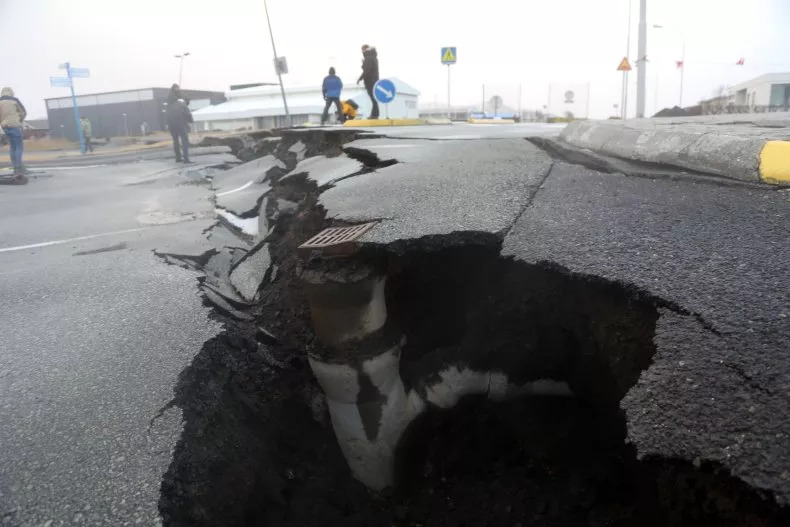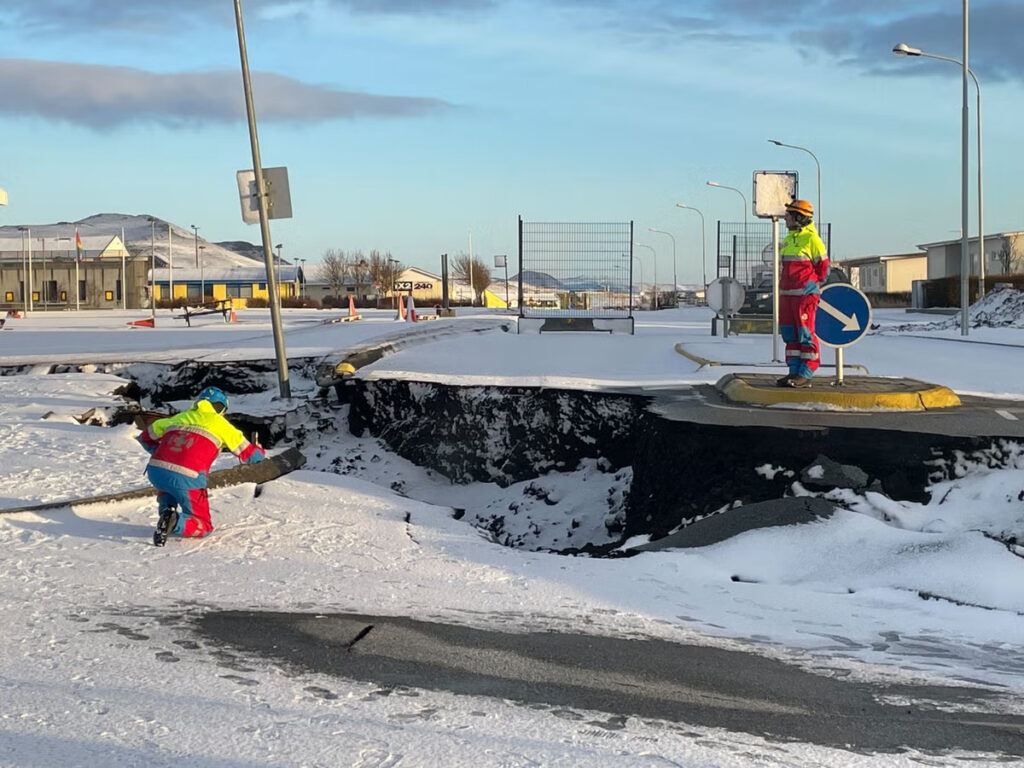A Swarm of Earthquakes
Since the midnight of 25 October, an intense earthquake swarm occurred near Svartsengi, north of Grindavík, with over 1000 earthquakes detected with the largest recorded magnitude of 4.5. Over the following days, the seismic activity continued with at least 1000 earthquakes being recorded in a span of 24 hours. Around 29 October, the seismicity north of Grindavík began to decline. However, the Reykjanes Peninsula started experiencing a period of complex volcano-tectonic unrest. Extended rifting of tectonic plates and heightened earthquake activity in the Svartsengi area may have induced structural weaknesses in the earth’s crust, potentially facilitating the movement of magma accumulated under the Fagradalsfjall Volcano. By 1 November, at least 10,500 earthquakes had been recorded in the peninsula and the frequency began fluctuating.
State of Emergency in Grindavik
By 11 November, the likelihood of a volcanic eruption occurring in the near future was deemed considerable. The Aviation Color Code was elevated to orange (heightened unrest with increased likelihood of eruption), indicating a potential risk to air travel due to ash.

As of early November 10, precautionary evacuation orders were issued in Grindavik Town, and a state of emergency was declared due to heightened volcanic activity at Fagradalsfjall Volcano on the Reykjanes Peninsula. Thousands of earthquakes were recorded over the past weeks, with decreasing size and intensity. The seismic activity was concentrated in the magma intrusion zone between Sundhnukur and Grindavik at depths of 2-5 km, with reports of significant damage to roads and buildings. Roads to and from the town remain closed. Evacuations affected thousands of people in Grindavik.
As of 27 November, while operations at Keflavik International Airport continue to remain operational, the Blue Lagoon chose to proactively shut down its services, impacting the operations at Blue Lagoon, Silica Hotel, Retreat Spa, Retreat Hotel, Lava, and Moss Restaurant. This decision stemmed from concerns about potential disruptions to the travellers’ experience. The closure will persist until 07:00 on November 30, after which the situation may be reevaluated.
Emerging Magma and Eruption Warnings
As of 24 November, Iceland was still on alert for a volcanic eruption in the southwest Reykjanes peninsula.
Although Grindavik experienced significant damage from seismic activity caused by magma intrusion, resulting in extensive chasms in the streets; with a decreasing trend in seismic activity, the Icelandic MET Office reported that the likelihood of an imminent volcanic eruption is diminishing over time. However, it was predicted that the areas between Hagafell and Sýlingarfell still face the possibility of volcanic magma eruption.
On 23 November, Iceland’s civil defense authority announced that the risk level associated with earthquakes in Grindavik has been downgraded from emergency to danger. The aviation colour code of the Icelandic Met Office for the volcanic system for the northern part of Reykjanes peninsula was also lowered to yellow. The volcano continues to show signs of activity above the normal level, however, the activity has decreased significantly and is being closely monitored.

Is it Currently Safe to Travel to Iceland?
The Reykjanes Peninsula in Iceland is currently experiencing heightened seismic activity, leading to the evacuation of Grindavík as a precaution. Despite this, flights at Keflavik International Airport, located 10 miles north of the affected area, are operating normally. British Airways and EasyJet also reported normal operations.
If you are in Iceland, you can leave as long as the airport remains open.
However, in April 2010, the eruption of the Icelandic volcano Eyjafjallajökull led to the closure of northern European skies for nearly a week due to concerns about volcanic ash potentially damaging aircraft engines. This resulted in the cancellation of over 50,000 flights affecting eight million travellers. However, in the ongoing scenario, volcanic ash has not been an issue so far.
Icelandic authorities continue to monitor the area, particularly the area northwest of Mt Thorbjörn near the Svartsengi power plant and the Blue Lagoon and reported that it is increasingly possible that a volcanic eruption could occur based on indications of volcanic activity above normal levels on the Reykjanes peninsula.
Plan your travel accordingly. Download SITATA’s Travel Safe App to stay informed about updates.



